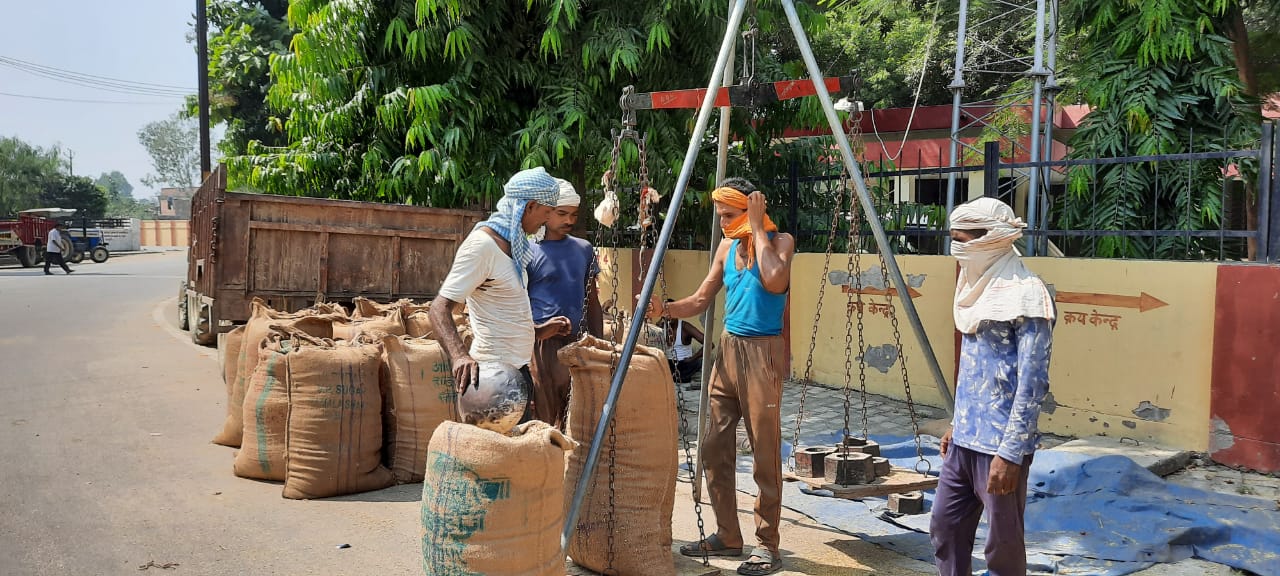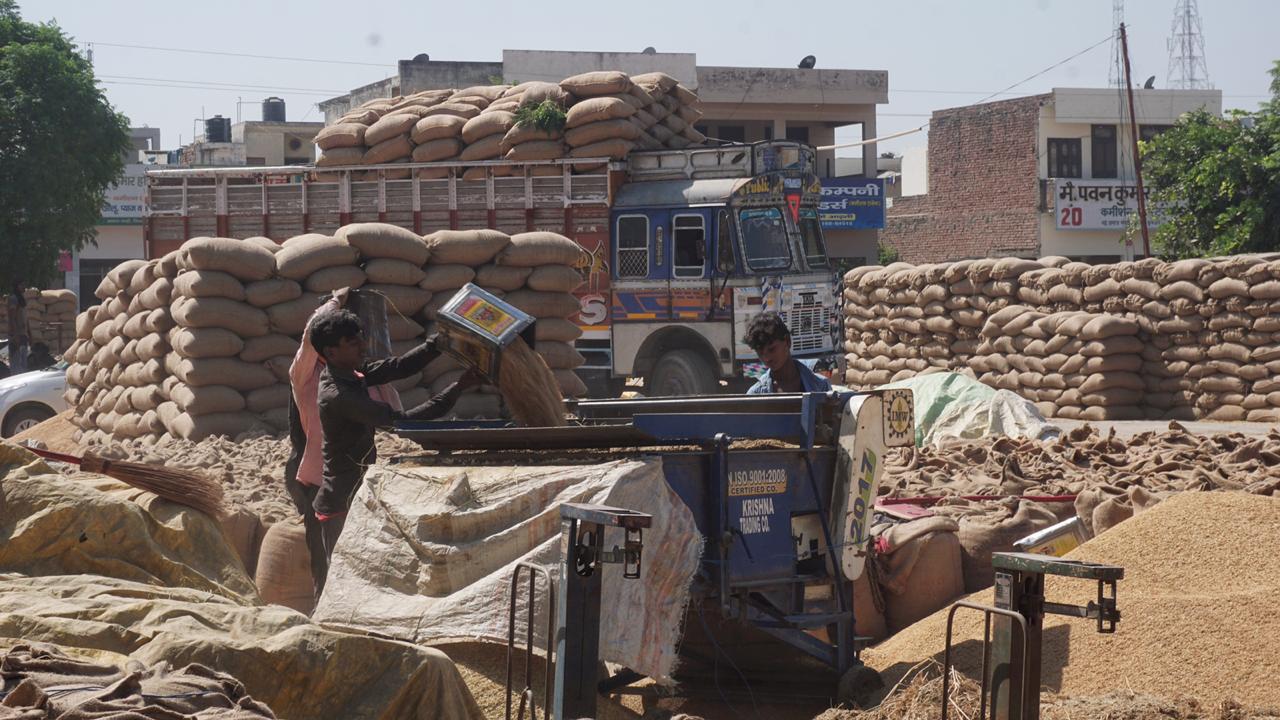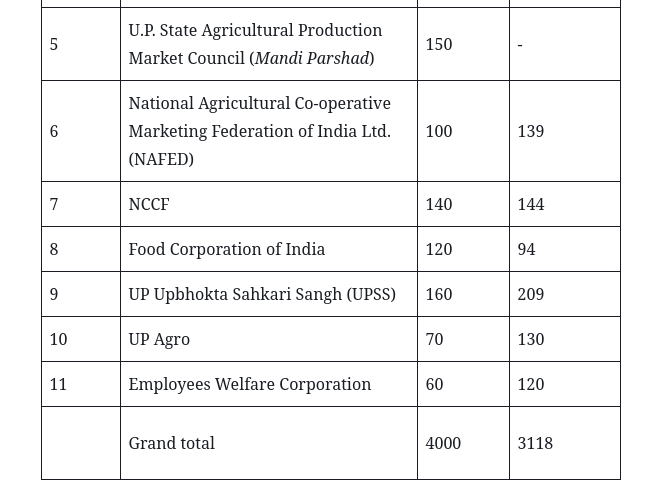Grain Drain: Farmers in Uttar Pradesh sell paddy below government rate to repay loans
While the Centre continues to assure farmers that it will stand by the minimum support price of Rs 1,888 per quintal, farmers are being compelled to sell their paddy at Rs 1,200 a quintal or less.

Jarnail Singh from Kabirganj in Pilibhit district in Uttar Pradesh has just returned from Paliya Mandi a dejected man. The 50-year-old was unable to sell his 250 quintals of ‘good quality’ paddy. “I had taken a trolley of paddy to the mandi, but no trader bought it even though I was willing to sell it at a much lower price than the government’s minimum support price (MSP) of one thousand eight hundred and eighty eight rupees per quintal,” Singh told Gaon Connection. The farmer was offering to sell his paddy at Rs 1,100 a quintal, Rs 700 less than the government fixed rate; even then, there were no takers, he said despondently.
Despite repeated assurances by the central government that it would safeguard the minimum support price (MSP) for the farmers, and that the latter would not be adversely impacted by the new agri laws that caused such an uproar in the agrarian community, the story on the ground is unfolding rather differently.
Farmers like Singh are finding it almost impossible to sell their produce at the MSP. They are desperate to sell because they have no godown to store their unsold paddy in and they need money to sow the next crop of potatoes or wheat. “The bank loan has to be repaid, the workers need their payment…” the distraught farmer trailed off. They find themselves holding unsold paddy, hard pressed for money and vulnerable to exploitation by middlemen to whom they are forced to sell their paddy at a throwaway price.
While the agri acts had also assured the farmers that they could directly sell their produce at the mandis, that is also not happening. “The government procurement centres invariably find fault with the quality of the paddy if brought to them directly by the farmers. But, when we sell the same farha (bad grain) to the traders at throwaway prices, it miraculously becomes all right,” Jarnail Singh complained to Gaon Connection.

According to the central government, compared to last year, there has been a 45 per cent increase this year in procurement of paddy at the MSP. In his tweet on October 11, Sudhanshu Pandey, secretary, department of food and public distribution, India, tweeted that while last year, 17.7 lakh metric tonnes were procured by the government as of October, this year the quantity has risen to 26.3 lakh metric tonnes in the same time period. In Uttar Pradesh alone the procurement this year as of October 8, is 4,423 metric tonnes while last year it was only 92 metric tonnes.
Growing problems
However, the numbers on ground differ as farmers are selling their paddy at a rate much lower than the MSP. “I have sold off my paddy crop for one thousand rupees because I had to sow potatoes and did not have enough money with me to hold on to paddy and at the same time begin sowing the next crop. When and how the government purchase will happen, no one knows,” Mewalal, a farmer in Lakhimpur said, resigned. Even in districts where government procurement has begun, the farmer is compelled to sell paddy at as low as Rs 1,000-1,200 in the open market.
“Needing money at home, I had to sell my own paddy at one thousand and seventy rupees,” Virendra Vishwakarma, from Tandpur village in Suratganj block of Barabanki District who has been procuring paddy, wheat and mustard at the local level and selling it to the wholesalers for the last several years, told Gaon Connection. “The farmer can’t wait further, so he is selling at whatever price he is getting,” he added. Vishwakarma has so far managed to sell 90 quintals of paddy, including his own 40 quintals.
Paddy procurement has commenced from October 1 in Pilibhit, Shahjahanpur, Lakhimpur and Sitapur in western Uttar Pradesh. Because of the rains in September, there had been moisture in the fields and so paddy harvesting in most of the districts has picked up only this week. The farmers who had sown the agaiti (early) crop are busy harvesting it these days. Meanwhile, potato sowing has also begun in the potato belt districts, including Kannauj, Agra, Mainpur, Kanpur and Barabanki. Farmers incur a lot of expenses at this time of the year and in order to meet them, they are selling paddy to private traders for a lot less than the government stipulated rates.

“Last year, in the beginning of October, paddy was selling for one thousand and five hundred rupees whereas this year it is selling at a much lower rate of thousand or one thousand and hundred rupees. I have heard that paddy’s MSP is a little more than the previous year’s rate of one thousand and seven hundred rupees. So we are incurring quite a heavy loss per quintal. This is why I have harvested only ten acres [4.04 hectare] so that I can meet my expenditure,” said Haripal Singh of Khajuriya village in Shahjahanpur.
But clearly, the farmers are a worried lot. “There is no demand for paddy in the mandi,” pointed out Gurchanan Singh of Lakhrawan village under Gola Tehsil in Lakhimpur district.
“The government has declared the MSP, so it must also arrange to buy paddy at that rate. The farmer needs money now to sow wheat, mustard and potato. There are only banners at the procurement centres assuring farmers of good days; but the millers are doing as they please. The government has failed the farmers,” said the farmer who has 15 acres [6.07 hectare] of paddy, of which he has harvested and sold only half.
All is well, says the government
“The rate for ordinary paddy has been set at one thousand eight hundred and sixty-eight rupees a quintal and for grade-A paddy the rate is fixed at one thousand eight hundred and eighty-eight rupees per quintal. Besides, there will be four thousand procurement centres where the paddy will be procured at the MSP,” Manish Chauhan, Commissioner, Department of Food and Logistics in Uttar Pradesh, said in a press statement on October 2.
According to the Uttar Pradesh government, 11 agencies including the UP State Food and Essential Commodities Corporation, the Pradeshik Cooperative Federation, public sector undertakings, Mandi Parishad and Food Corporation of India shall procure the paddy through registered cooperative societies, farmer growers groups, multi state cooperative societies, etc. The central government has directed that the procurement goes as per the new agri laws. Anyone who has a PAN card can buy the grains.
Other than in Uttar Pradesh, according to the central government, procurement has begun at several centres in Haryana and Punjab from September 26 and from October 1, respectively. It also stated that rapid procurement is underway in many more states and more than half a million tonnes of paddy have already been procured at MSP in the first week of October.
As per the data released by the union ministry of consumer affairs, food and public distribution on Sunday (October 4), 573,339 tonnes of paddy has been procured in the current Kharif season 2020-21 as of October 3. The ministry said procurement was made at MSP and it has benefitted 41,084 farmers.
After the uproar over the matter of MSP in the new agri bills, the central government had assured the continued procurement of food grains from the farmer at the MSP. It has promised that farmers will continue to get the benefit of MSP. However as per reports, Gaon Connection has received, from several districts in Uttar Pradesh, between September to the first week of October, these promises have not come to fruition.
It is the same in other states too. Mandis in Haryana are crowded with farmers who have unloaded their produce and have been waiting for several days to sell it. Farmers in Madhya Pradesh are also finding it difficult to find buyers and competitive rates to sell their paddy. According to the findings by Gaon Connection, in Satna, Madhya Pradesh, the mandis are closed and the millers are paying only between Rs 1,300 and Rs 1,400 per quintal for good paddy.
Sharecroppers’ woes
It is mandatory for a farmer who wants to sell paddy at a government procurement centre to register. Only the farmer who has the land rights, bank passbook and an Aadhaar card will be able to carry out the sale.
A sharecropper or bataidar, therefore, cannot sell his paddy at a government procurement centre. Harun Ali of Nidanpur village in Shahjahanpur, in Uttar Pradesh, a bataidar had sown paddy on about 16 acres [6.47 hectare] of leased land. Although he has harvested his crop, it has failed to fetch him a good price. “The position of paddy is very bad,” rued Harun, “The difference of a hundred rupees or so is acceptable but Katna Mandi (local mandi) has opened at the rate of one thousand and one hundred and ten rupees per quintal. That is more than seven hundred rupees per quintal difference,” he calculated, adding if he sold at this rate, after paying off the land owner, a bataidar like him would have no money left for meeting other expenses.
The Uttar Pradesh government has created a time table for paddy procurement based on which the officers in-charge have been appointed in all the districts, and 1,171 purchase centres in western Uttar Pradesh have been approved.
Paddy mills have also been registered. 1,905 rice mills had been registered, while 1,736 rice mills have been geo-tagged as of October 1. In Uttar Pradesh, registrations are ongoing through e-procurement portal. So far, 207,280 farmers have registered.
Names of Agencies


(with inputs from Mohit Shukla from Lakhimpur and Pilibhit, Virendra Singh from Barabanki, Sachin Tulsa Tripathi from Satna, Ram Ji Mishra from Shahjahanpur and Sumit from Unnao)
Read this story in Hindi.

